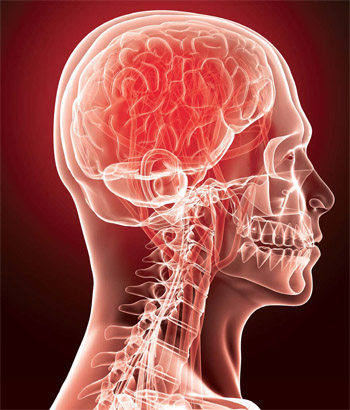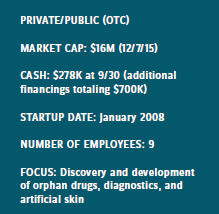Amarantus: Risen From The Ashes
By Wayne Koberstein, Executive Editor, Life Science Leader
Follow Me On Twitter @WayneKoberstein
The Enterprisers: Life Science Leadership In Action
 A simple twist of fate is all it takes to knock you off your original track. In the case of the company that would be reborn as Amarantus, it was another company’s bad luck in the clinic that ended its first push for partnering and funding. Gerald Commissiong, president and CEO, recounts how his father’s earlier Canadian startup fell after a trial of Amgen’s competing compound for Parkinson’s disease failed. “Amgen was unable to deliver the drug to the right location in the brain, and therefore investors felt, if Amgen couldn’t succeed, my father’s company would not either,” he says.
A simple twist of fate is all it takes to knock you off your original track. In the case of the company that would be reborn as Amarantus, it was another company’s bad luck in the clinic that ended its first push for partnering and funding. Gerald Commissiong, president and CEO, recounts how his father’s earlier Canadian startup fell after a trial of Amgen’s competing compound for Parkinson’s disease failed. “Amgen was unable to deliver the drug to the right location in the brain, and therefore investors felt, if Amgen couldn’t succeed, my father’s company would not either,” he says.
The compound was MANF (mesencephalic- astrocyte-derived neurotrophic factor), a difficult delivery challenge that did ultimately prove insurmountable for the smaller company with dwindling funds. The company was Prescient NeuroPharma, founded by Dr. J.W. Commissiong in 1999 and burned out in 2003, leaving its core IP for the lead compound and discovery platform for neurotrophic factors, PhenoGuard, sitting in ashes.
 It would be five years before the younger Commissiong recovered the IP from Prescient and fired up a new version of the original enterprise — with significant enhancements. Not only has the new company found an apparent solution to the delivery problem with MANF, it has also broadened its development program and added several other therapeutics to its pipeline, as well as a diagnostics business and an artificial skin product. Those additions are attracting funds to Amarantus that give some support to the MANF program, now ramping up to Phase 1 trials for Parkinson’s and two rare but critical eye conditions.
It would be five years before the younger Commissiong recovered the IP from Prescient and fired up a new version of the original enterprise — with significant enhancements. Not only has the new company found an apparent solution to the delivery problem with MANF, it has also broadened its development program and added several other therapeutics to its pipeline, as well as a diagnostics business and an artificial skin product. Those additions are attracting funds to Amarantus that give some support to the MANF program, now ramping up to Phase 1 trials for Parkinson’s and two rare but critical eye conditions.
But for years after its founding, failure to achieve a delivery solution for the product’s use in Parkinson’s continued to plague the company, so along with refocusing the MANF program on ophthalmology, Amarantus made the move to diversify generally, according to Commissiong. It was an opportunistic strategy, he says — mainly acquiring assets that came up through the relationships he had built in putting the company together — but, at least initially, the in-licensing stayed close to the company’s roots in Parkinson’s, though it began with diagnostics.
“There’s a story behind every product and every acquisition,” says Commissiong, relating how the company began and expanded its diagnostics line. “We were in the Parkinson’s space. We had already licensed a diagnostic for Parkinson’s, believing there was a lot of interest in peripheral diagnosis of neurological conditions using biomarkers. In Parkinson’s, our biomarker was a series of proteins, or protein signature. Then, as we improved our understanding of a diagnostic opportunity, we saw Alzheimer’s as a much larger opportunity and a much greater medical need. And so we diversified into peripheral diagnosis of Alzheimer’s.” In a separate division, Amarantus Diagnostics, the company has commercialized its Alzheimer’s diagnostic for research, LymPro, and also is developing the MSPrecise diagnostic for multiple sclerosis.
Next, the company brought in eltoprazine, a small molecule 5HT1A/1B partial agonist, now in late-stage development for treating Parkinson’s disease levodopa-induced dyskinesia (PD-LID) and adult attention deficit hyperactivity disorder (ADHD). Eltoprazine had been thoroughly tested in preclinicals and human safety trials by a series of owners — Solvay, then Abbott and PsychoGenics — before Amarantus licensed it and took over its development. The compound is also ready to move into Phase 2 development for Alzheimer’s aggression. Amarantus asked the FDA to grant orphan-drug status to eltoprazine for the PD-L1D indication in October 2015.
Artificial skin was another matter entirely. For the first time, Amarantus bought an entire company, Cutanogen, to obtain Engineered Skin Substitute (ESS). ESS is a regenerative medicine product made by starting with a patient’s own skin tissue to culture an epithelium, or outer sheaf of cells, together with a collagen-fibroblast implant to replace the epidermal and dermal layers of the skin. ESS is entering a Phase 2 clinical trial with the U.S. Army for treatment of severe burns in adults, treating soldiers with full-thickness burns covering over 50 percent of their bodies.

"Having a pipeline that covers multiple scientific and disease areas is a big advantage because of cross-pollination."
Gerald Commissiong
President and CEO, Amarantus
Commissiong says various versions of ESS have been used in the treatment of more than 140 pediatric patients at the Shriner’s Hospital in Cincinnati, with impressive results. A presentation to the FDA in 2012 showed a reduction in mortality of more than 25 percent and a significantly faster time to full wound closure in a 16-subject, compassionate-use study.
“Right now we are targeting burns because there the primary problem is loss of skin, in which you are completely immunologically compromised,” he says. “Reestablishing that barrier is paramount to survival and to limiting infection, which has its own set of consequences.”
Along with the product, he says, Amarantus also acquired strong data in the use of ESS in congenital hairy nevus, an inherited disorder creating what amounts to a giant mole over a large percentage of the body that can sometimes become cancerous. “You do a skin graft on a 6-9 month-old patient, and follow up 13 years later, to find the skin replacement has grown and the child has never had to go through another revision surgery, so that patient is effectively cured of the condition.”
These days, the company is strongly inclined to sell or spin off its diagnostics business. Commissiong says the unit will be bringing in “much more qualitative revenue than quantitative revenue in the nearterm,” and the revenue will be insufficient to support therapeutic portfolio development, which is much more expensive than developing diagnostics. The move to make the diagnostics unit separate and independent from Amarantus may also be good for the neurodegenerative-disease space in general, as more and more developers concentrate on detecting and treating the disease as early as possible.
FOUNDING ACTION
For all of its therapeutics, Amarantus has so far concentrated on orphan indications, but the company also shows a strong willingness to apply each product’s mechanism of action (MoA) as broadly as possible over time. And the best example of that is still its original drug candidate — MANF. The particular neurotropic factor appears to be active in a host of related, and in some cases seemingly unrelated, conditions and disease areas, perhaps because its MoA is essentially to correct protein misfolding.
“MANF acts like a chaperone and basically helps cells get through times of stress, whether from injury or disease,” says Commissiong. “There are also some other interesting components of the growth factor related to neurotransmitters — a receptor mechanism that modulates the action of calcium channels.” It also appears to protect injured cells, as in reperfusion events, by interfering with the apoptosis pathway, according to the company.
“Having a pipeline that covers multiple scientific and disease areas is a big advantage because of cross-pollination,” he maintains. “It’s not usually about indication, it’s about mechanisms, and those mechanisms get applied across many diseases. For example, working on our diagnostic blood test for Alzheimer’s disease gives us tremendous insights into the immune system, therapeutic avenues, tissue generation — many things going on in the body that are not well-known. Our neurotrophic factor has a broad swath of potential applications, so that has led us into science in numerous areas. It’s interesting to see them all interplay with one another.”
In fact, the list of current and prospective pipeline indications for MANF is quite long. The lead program is for retinitis pigmentosa (RP), the name for a set of congenital diseases that can lead to blindness by causing the retina to degenerate. But, in addition to other conditions in the eye and specific neurological indications such as Parkinson’s disease and traumatic brain injury (TBI), the company envisions possible future programs for various conditions in diabetes, ischemic heart disease, and Wolfram Syndrome.
Commissiong points out the importance of delivery technology as a distinguishing factor among the variety of applications possible for a single protein such as MANF. With biologics, each indication may require a different drug-device combination — in effect, a different product. In the research phase, the emphasis is on defining the drug mechanism and how it might affect the symptoms of various diseases. But once the drug enters the commercialization stages, the developer must select or create a mode of delivery that will accommodate the specific condition, patient needs, practice setting, and so on. Then clinical trials will test the drug’s ability to alter the disease state and cause functional improvement.
To solve the delivery problem for the Parkinson’s program, Commissiong says the company found a “better mousetrap” at the University of Bristol in the work of a famous neurosurgeon, Steven Gill, who overcame a lot of the deficiencies of previous direct injection to the brain technologies. Gill recently published the results from Amarantus-funded animalmodel research showing his method appears to deliver the MANF protein to the brain in the right quantities and infuse the key areas without leaking into the surrounding areas. “Now we have a good handle on what it will take to translate the technology into human use,” Commissiong says.
Meanwhile, he adds, the lead strategy for MANF is to stay focused primarily on orphan ophthalmological indications. “We like ophthalmology because we’re talking about direct injection to the eye, a discrete organ where we use really small quantities of the drug, so there is limited toxicology risk. Our strategy is to bring a product to market as quickly as possible that can address a key unmet need in the ophthalmology space, where there are a lot of unmet needs.”
Commissiong says the second ophthalmology program for MANF, retinal artery occlusion (RAO), is basically a ministroke of the eye requiring similar urgency. “Much like a regular stroke, time-to- treatment is absolutely paramount for RAO because the occlusion leads to downstream effects, so the delivery may be drastically different than with a longterm condition like retinitis pigmentosa.” FDA has granted orphan-drug status to MANF for the RAO indication, and both the FDA and the European Union have placed their respective orphan designations on the compound for treating retinitis pigmentosa.
Despite, or maybe because of, the wide range of possibilities for MANF, its development is still in the early stage. But Commissiong says the company is establishing a GMP manufacturing process for the protein and expects to be in the clinic with the growth factor in 2017.
Looking further into MANF’s future, he sees gene therapy as one possible alternative “delivery” route. “Gene therapy has a lot of promise. We haven’t done anything yet, although we may seek to partner that out because there are so many capabilities required in gene therapy we just don’t have. Replacing missing or defective genes is probably a winning strategy, but it remains to be seen whether it is a durable, long-lasting technique. Using it as a method just to deliver a protein that has some important, but maybe ancillary, benefit is probably much more challenging, largely because you’re infecting sick cells.”
FUTURE POSITION
Turning from the view ahead to the view behind, Commissiong also gives a good account of where the company stands right now. “We started a company that needed improvement in its intellectual property. We built a tremendous portfolio of IP for MANF, not only around composition of matter, but various and intertwining uses that really create a strong position in the MANF space. So I think it would be very challenging for anybody to try to develop products in the space without coming through us.” He has equal confidence in the company’s IP position for its other assets.
On the MANF development side, however, Commissiong rates the progress as slow. “GMP manufacturing of biologics is time-consuming and expensive, and it’s difficult for a company our size to marshal the needed resources unless it is VC-funded — that has been our challenge,” he says. “As an over-the-counter public company, we’re in a sort of no-man’s land, so funding has been sporadic. We’re not private, so we can’t really access private sources of capital, but we’re not truly public because we’re not on the NASDAQ. The larger investment funds can’t invest on the OTC market, so we have had to take funding from various hedge funds to keep us going.”
Amarantus has raised about $40 million total, $30 million since late 2014. “A lot of our funds have gone toward product acquisitions, and now we have a tremendous portfolio that we want to advance through value-building milestones as we go forward,” Commissiong says. Of note, the company has received significant grants from the U.S. Army, for the ESS program, and patient associations such as the Michael J. Fox Foundation for MANF in Parkinson’s disease.
Commissiong cites an industry veteran on his board of directors, Joseph Rubinfeld — one of the founders of Amgen and inventor of amoxicillin — on how a company can endure and prosper in the life sciences industry. “This is a tough business, but Dr. Rubinfeld’s advice is always, ‘If you can stay on the playing field long enough, and you have the right assets, eventually the company will succeed.’ Three years ago all we had was the preclinical data in neurotrophic factors. Today, we have the skin product moving into Phase 2 for adult burns and probably moving to Phase 3 trials for congenital hairy nevus and pediatric burns in the second half of next year.”
Durability plus assets equals success. It’s a simple formula containing thousands of variables and constant perils. But for this company that has seen the fire and risen from the ashes, all things now seem possible.
Do you have something to say about Amarantus and its MANF delivery solution and expanded pipeline? Please post your comments online with this article under Current Issue (January 2016) or Past Issues at lifescienceleader.com.
